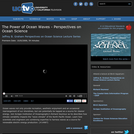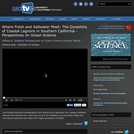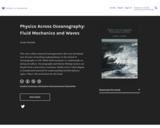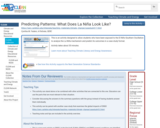
Join Jerry Bode and Warren Smith as they recount the fascinating history of the geological collections at Scripps. (57 minutes)
- Subject:
- Geology
- Oceanography
- Physical Science
- Material Type:
- Lecture
- Provider:
- UCTV Teacher's Pet
- Date Added:
- 10/12/2010

Join Jerry Bode and Warren Smith as they recount the fascinating history of the geological collections at Scripps. (57 minutes)

Ocean Waves not only provide recreation, aesthetic enjoyment and an occasional rearrangement of our shorelines, but can potentially be tapped as a source for cleaner energy. Join Scripps Institution of OceanographyŐs Richard Seymour as he describes how climate variability impacts the "wave climate" of the North Pacific Ocean. Learn how scientists and engineers are combining expertise to harness Waves as a source for renewable electric energy production. (54 minutes)

Join Dan Cayan as he describes his research on the impacts of climate variability and attempts to improve climate and extended weather forecasts in the California region. (59 minutes)

Scripps is home to the largest academic research fleet in the nation. Learn more about this incredibly valuable resource from Associate Director Dr. Robert Knox, head of Scripps marine operations and technical support. (58 minutes)

Join Lisa Tauxe as she describes her research into the long-term behavior of Earth's magnetic field. (42 minutes)

Join Dr. Lynne Talley as she describes how she and others are using decades of ocean observations from floats, research vessels, and merchant ships to discern the long-term signal of climate change that is recorded in our oceans. (49 minutes)

Join Scripps Institution's David Hilton as takes us on a journey to Costa Rica on the first stage of research to find out if volcanoes put out as much as the earth's mantle takes back during the processes of subduction and volcanism. (28 minutes)

Join Kendall Melville as he describes his work on Waves that occur both at the surface and in the ocean's interior and learn the profound influence their energy has on oceanographic and climatic processes. (49 minutes)

Join Scripps physical oceanographer Clint Winant as he describes this complex interface between the land and sea. Learn how he and his colleagues are providing insight into how human activities can impair this fragile ecosystem. (54 minutes)

Modern oceanography has been built on a legacy of centuries of seagoing dating back to ancient times. Join distinguished Scripps Emeritus Professor Joe Reid as he describes what the earliest sailors knew about the oceans and how technical achievements through the ages have allowed ocean explorers to venture to the far reaches of the globe. (51 minutes)

Short Description:
This class reflects material and approaches that were developed over 25 years of teaching undergraduates in the School of Oceanography at UW. While fluid mechanics is traditionally an advanced subject, Oceanography and Marine Biology majors can benefit from a more basic treatment, ideally early in their degree, as foundational material for understanding interdisciplinary topics. That is the motivation for this book.
Word Count: 28167
(Note: This resource's metadata has been created automatically by reformatting and/or combining the information that the author initially provided as part of a bulk import process.)

Average inquiry level: Guided inquiry
This is a series of scaffolded modules to guide students in understanding Plate Tectonic Theory, from its history to modern applications, and is designed for the asynchronous class. These modules may be used as individual classroom assignments or as labs. They were written with the intention of students working from 12-16 hours during an asynchronous week. They can also be used in classes with different modalities. This is not designed for one 3-hour lab session, although individual modules could be used as labs.
(Note: this resource was added to OER Commons as part of a batch upload of over 2,200 records. If you notice an issue with the quality of the metadata, please let us know by using the 'report' button and we will flag it for consideration.)

This course explores the following topics: derivation of elastic and plastic stress-strain relations for plate and shell elements; the bending and buckling of rectangular plates; nonlinear geometric effects; post-buckling and ultimate strength of cold formed sections and typical stiffened panels used in naval architecture; the general theory of elastic shells and axisymmetric shells; buckling, crushing and bending strength of cylindrical shells with application to offshore structures; and the application to crashworthiness of vehicles and explosive and impact loading of structures. The class is taught during the first half of term.

To prepare for this exercise, students will read about the Earth's energy balance, the electromagnetic spectrum (including visible solar and invisible infrared energy), the effect of the earth's atmosphere, and the earth's resulting general oceanic and atmospheric circulation. For this I like Chapters 3, 4, & 5 in "The Earth System" (2nd Ed.) by Kump, Kasting, & Crane. The students' first step is to estimate zonal averages of Incoming Solar (Shortwave), Absorbed Shortwave, and Outgoing Longwave Radiation from 11x17in color maps of Earth Radiation Budget Experiment (ERBE) data. Then I remix the groups and they create zonal averages of these data at particular longitudes (like Fig. 2-14 in Ruddiman, "Earth's Climate: Past & Future").
(Note: this resource was added to OER Commons as part of a batch upload of over 2,200 records. If you notice an issue with the quality of the metadata, please let us know by using the 'report' button and we will flag it for consideration.)

Students in a Population and Community Ecology class participate in coastal marine research focused on understanding factors determining population sizes and community interactions, particularly in the context of species that appear to be shifting their ranges with climate change. Students participate in all aspects of the research from making observations and collecting data in the field to defining questions, stating hypothesis, designing and completing statistical analysis, and interpreting and presenting results. The outcomes are a research proposal, research paper, and poster presentation. All are intended to be at a level appropriate for use as a writing sample or presentation at undergraduate conferences. Results are incorporated into the ongoing research project led by the course instructor and graduate student teaching assistant.
(Note: this resource was added to OER Commons as part of a batch upload of over 2,200 records. If you notice an issue with the quality of the metadata, please let us know by using the 'report' button and we will flag it for consideration.)

The students must use crayons or colored pencils to create maps of global precipitation and evaporation rates. One worksheet is provided to each group of students. Then a representative from each group explains their map to the rest of the class, and the instructor shows a similar map from NOAA or NASA.
(Note: this resource was added to OER Commons as part of a batch upload of over 2,200 records. If you notice an issue with the quality of the metadata, please let us know by using the 'report' button and we will flag it for consideration.)

In the Web-based game Predator Protector, students take on the role of an Ocean Adventures expedition volunteer member. In this role, students are charged with protecting three species of sharks from danger in order to defend the balance of nature in the ecosystem that these top predators help to maintain. Use the tips and handouts below to turn the Predator Protector game into a structured learning activity for your students.

This is an activity designed to allow students who have been exposed to the El NiÃo-Southern Oscillation to analyze the La NiÃa mechanism and predict its outcomes in a case study format.

This course presents principles of naval architecture, ship geometry, hydrostatics, calculation and drawing of curves of form, intact and damage stability, hull structure strength calculations and ship resistance. It introduces computer-aided naval ship design and analysis tools. Projects include analysis of ship lines drawings, calculation of ship hydrostatic characteristics, analysis of intact and damaged stability, ship model testing, and hull structure strength calculations.

This course introduces theoretical and practical principles of design of oceanographic sensor systems. Topics include: transducer characteristics for acoustic, current, temperature, pressure, electric, magnetic, gravity, salinity, velocity, heat flow, and optical devices; limitations on these devices imposed by ocean environments; signal conditioning and recording; noise, sensitivity, and sampling limitations; and standards. Lectures by experts cover the principles of state-of-the-art systems being used in physical oceanography, geophysics, submersibles, acoustics. For lab work, day cruises in local waters allow students to prepare, deploy and analyze observations from standard oceanographic instruments.